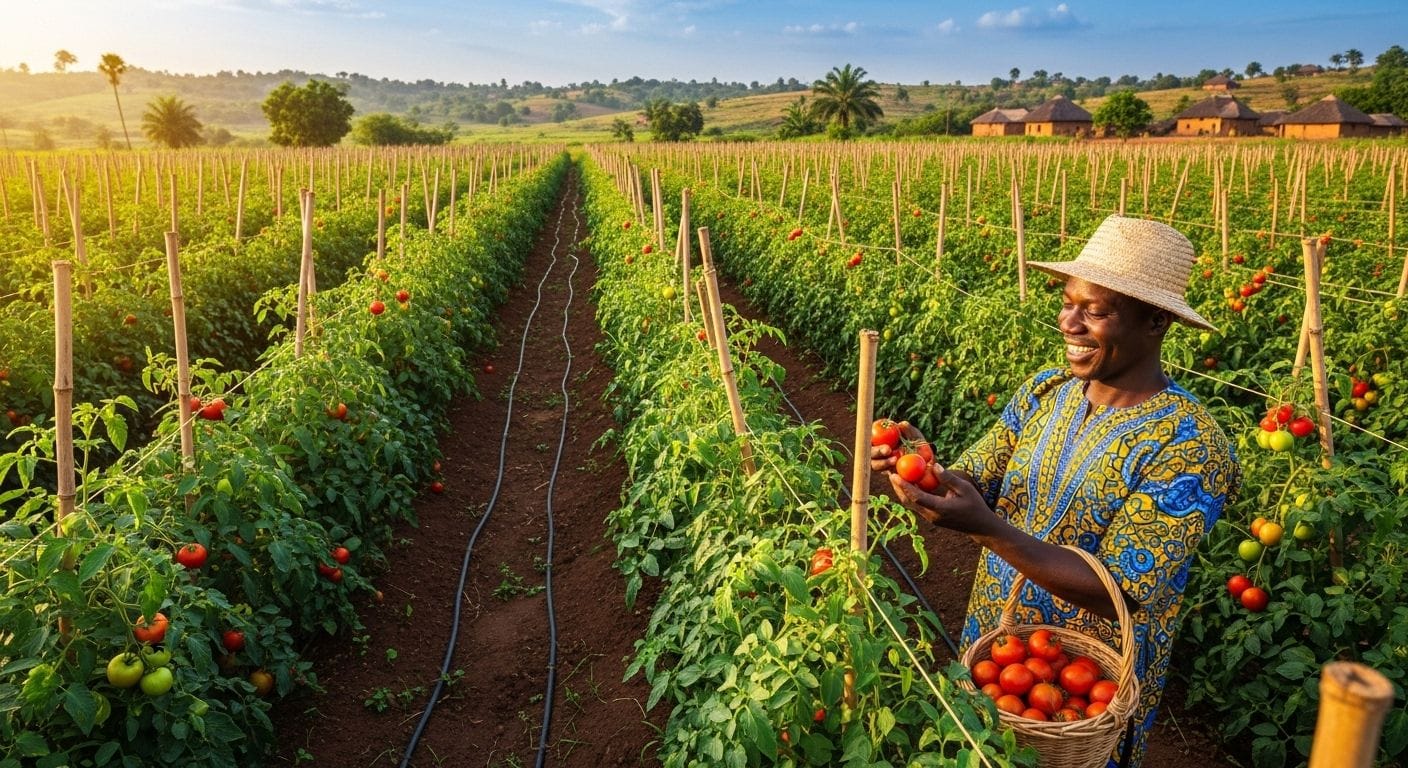Starting a Profitable Tomato Farm in Ghana: A Complete Guide
Tomato is a cornerstone of Ghanaian cuisine, found in nearly every stew, soup, and sauce. This constant demand makes tomato farming a potentially lucrative venture for aspiring entrepreneurs. Historically dubbed “the red cocaine” in the 80s for its high returns, the industry has faced challenges but remains a field of immense opportunity. This complete step-by-step guide for entrepreneurs will walk you through how to start a profitable tomato farm tomato varieties in Ghana, leveraging best practices and research-backed insights to ensure a bountiful and profitable harvest.
Why Start a Tomato Farm in Ghana? The Business Case
Despite being a major regional producer, Ghana still imports significant quantities of tomatoes—around 7,000 metric tonnes of fresh tomatoes and 27,000 metric tonnes of processed paste annually. This gap between local supply and high demand creates a clear market opportunity for dedicated farmers. With the right techniques, a small investment can yield substantial returns, with some farmers reporting earnings of over GHS 100,000 in just a few months.
Phase 1: Planning Your Tomato Farming Venture
Success begins long before the first seed is planted. Careful planning is the foundation of a thriving agricultural business.
Choosing the Right Location
The ideal location for tomato cultivation features specific ecological conditions:
- Climate: Tomatoes thrive in areas with warm, sunny days and cool nights. High temperatures and dry air can lead to poor flowering and fruit set.
- Water Access: A reliable water source is non-negotiable. Situating your farm near a river or borehole is ideal. If not possible, consider investing in water storage tanks, especially if using drip irrigation.
- Soil Type: Deep, well-drained loamy soils are best. The optimal soil pH is between 6.0 and 7.5. A soil analysis is highly recommended to understand nutrient deficiencies and pH levels. Lime can be used to raise low pH, while gypsum can lower high pH.
- Land Topology: Gently sloping land is preferred as it promotes drainage and prevents waterlogging, especially during rainy seasons.
Selecting the Best Tomato Varieties for Ghana
Choosing the right variety is critical. Consult with a local agricultural extension officer for advice, but consider these factors:
- Pest & Disease Resistance: Select varieties known for their resistance to common local diseases like Tomato Leaf Curl Virus and Bacterial Wilt to reduce production costs.
- Market Demand: Are you selling to fresh markets or processors? Varieties like Roma are often preferred for processing into paste.
- Recommended Varieties: Some well-regarded varieties in Ghana include Jaguar, Roma, Rio Grande, Pectomech VF, Ada cocoa, and Wosowoso.
Budgeting and Cost Analysis for a One-Acre Farm
Understanding the financial aspects is crucial for any entrepreneur planning a successful tomato farming business in Ghana. Below is a sample budget breakdown for a one-acre farm. Costs are estimates and can vary based on location and suppliers.
| Item | Description | Estimated Cost (GHS) |
|---|---|---|
| Land Preparation | Ploughing, harrowing, and creating ridges. | 800 – 1,500 |
| Seeds/Seedlings | High-quality, certified seeds or nursery-raised seedlings. | 500 – 1,000 |
| Fertilizers | Compost, NPK, Sulphate of Ammonia, Potassium Nitrate. | 1,500 – 2,500 |
| Pesticides | Insecticides, fungicides, and weedicides. | 800 – 1,200 |
| Labor | Nursery, transplanting, weeding, pruning, harvesting. | 2,000 – 3,500 |
| Irrigation | Pump, pipes, or drip system installation/running costs. | 1,000 – 4,000+ |
| Stakes & Twine | For supporting the plants. | 500 – 800 |
| Total Estimated Startup Cost | 7,100 – 14,500 |
Phase 2: From Seed to Seedling – The Nursery Stage
Tomato seeds are delicate and require a nursery phase to ensure a high germination rate before being transplanted to the main field.
- Prepare the Seedbed: Create raised beds about 15cm high with finely tilled soil. Solarize the bed by covering it with plastic for 5-8 weeks to kill pathogens.
- Sowing Seeds: Plant seeds at a shallow depth of about 1cm in drills spaced 15cm apart. Cover lightly with soil. The required seed rate is about 300-450g per hectare.
- Mulch and Water: Cover the bed with dry grass or palm fronds to retain moisture and reduce soil splash. Water gently, preferably in the morning. Seedlings should emerge in about 8 days.
- Thinning and Hardening Off: Once seedlings have three true leaves, remove weaker ones. A week before transplanting, reduce watering frequency and remove any shade to “harden off” the plants, preparing them for field conditions. Seedlings are typically ready for transplanting in 3-4 weeks.
Phase 3: Cultivation Best Practices for a Bountiful Harvest
Following these cultivation best practices is fundamental to running a profitable tomato operation in Ghana. Your hard work in the nursery pays off here.
Transplanting
Transplant seedlings in the late afternoon or evening to reduce transplant shock. Water the nursery thoroughly before uprooting. Plant seedlings in holes with a spacing of approximately 60cm by 45cm.
Fertilization Schedule
To achieve high yields of up to 40 tonnes per hectare, a strategic fertilization plan is necessary:
- Basal Application: Apply a phosphate-rich fertilizer during planting to encourage strong root development.
- 2-3 Weeks After Transplanting: Apply NPK 15-15-15 fertilizer to promote vegetative growth.
- 4-5 Weeks After Transplanting: Apply Potassium Nitrate (100kg/hectare) to support flowering and fruit development.
- 6-8 Weeks After Transplanting: Apply Sulphate of Ammonia (100kg/hectare) in two split applications.
- Flowering Stage: Top dress with an NPK fertilizer again at the start of flowering and repeat after the first harvest.
Pruning and Staking (Support)
Supporting plants vertically with stakes and twine is crucial for high productivity. It keeps fruit off the ground, improves air circulation, and makes spraying easier. Prune regularly by removing side shoots (suckers), old leaves, and diseased foliage. This directs the plant’s energy towards fruit production.
Phase 4: Protecting Your Investment: Pest and Disease Management
Pests and diseases are a major challenge for tomato farmers in Ghana and can lead to total crop loss if not managed effectively.
Common Pests
- American Bollworm: Larva bores into the fruit, causing significant damage.
- Whiteflies, Aphids, Thrips: These insects suck sap and can transmit viral diseases.
- Root-Knot Nematodes: These microscopic worms attack the roots, causing the plant to wilt.
Control involves timely application of appropriate insecticides. Research in the Bono and Ahafo regions shows farmers commonly use products with active ingredients like Lambda-cyhalothrin. Always follow expert advice on application rates.
Common Diseases
- Tomato Blight (Late and Early): A fungal disease causing brown lesions on leaves, stems, and fruit. It thrives in moist conditions.
- Bacterial Wilt: Causes sudden wilting and death of the plant. Use certified seeds and practice crop rotation to manage it.
- Blossom End Rot: Caused by calcium deficiency and irregular watering. Correct with calcium-based foliar sprays and consistent irrigation.
Control diseases using recommended fungicides (Mancozeb is commonly used) and practicing good farm sanitation. Note that studies show some unregistered pesticides are in circulation; always purchase from reputable agro-dealers.
Phase 5: Harvesting and Maximizing Profitability
Your journey to building a thriving tomato enterprise in Ghana culminates in smart harvesting and marketing strategies.
When and How to Harvest
Tomatoes are typically ready for harvest 70-90 days after transplanting, depending on the variety. The harvest stage depends on your market. For distant markets, harvest when fruits are mature and firm but still greenish-pink (the “breaker stage”). For local markets, you can harvest when they are fully red but still firm.
The Key to Profit: Choosing Your Marketing Outlet
How you sell your tomatoes dramatically impacts your bottom line. A crucial study on tomato how to start a profitable **tomato farm in Ghana** Ghana revealed a significant difference in profitability based on the marketing channel:
- Selling to Wholesalers: Farmers who sold their produce in bulk to wholesalers recorded an average profit of GHS 7.86 per 25kg crate.
- Selling to Retailers: In contrast, farmers who sold directly to retailers experienced an average loss of GHS 5.36 per crate, likely due to smaller transaction volumes, higher time costs, and spoilage.
This data strongly suggests that securing agreements with wholesalers is a more profitable strategy for commercial tomato farmers.
Conclusion: Your Path to Success
Tomato farming in Ghana presents a genuine opportunity for wealth creation. By combining careful planning, adopting modern agronomic practices, managing pests and diseases responsibly, and making strategic marketing choices, you can turn a plot of land into a highly profitable business. The demand is constant; with dedication and the knowledge from this guide, your success is ripe for the picking.











